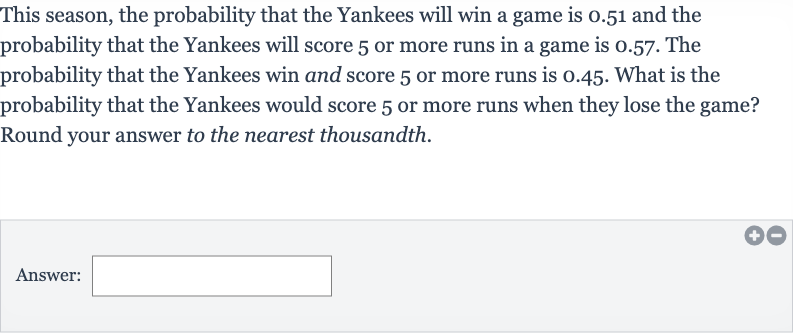AI tutor
Welcome to Bytelearn!
Let’s check out your problem:

This season, the probability that the Yankees will win a game is . and the probability that the Yankees will score or more runs in a game is . . The probability that the Yankees win and score or more runs is . . What is the probability that the Yankees would score or more runs when they lose the game? Round your answer to the nearest thousandth.Answer:
Full solution
Q. This season, the probability that the Yankees will win a game is . and the probability that the Yankees will score or more runs in a game is . . The probability that the Yankees win and score or more runs is . . What is the probability that the Yankees would score or more runs when they lose the game? Round your answer to the nearest thousandth.Answer:
- Define Events and Probabilities: Define the events and given probabilities.Let's denote the events as follows:: The Yankees win a game.: The Yankees score or more runs in a game.We are given the following probabilities: (Probability that the Yankees win) (Probability that the Yankees score or more runs) (Probability that the Yankees win and score or more runs)
- Calculate Probability of Yankees Losing: Calculate the probability that the Yankees lose a game.Since the probability of winning is , the probability of losing, which we'll call , is the complement of .
- Use Conditional Probability Definition: Use the definition of conditional probability.We want to find the probability that the Yankees score or more runs given that they lose the game, which is . According to the definition of conditional probability:We already have , but we need to find , which is the probability that the Yankees score or more runs and lose the game.
- Find Using Complement: Find using the complement of the event . The event is the complement of within the context of . This means that: Substituting the given values, we get:
- Calculate : Calculate using the values from steps and .Now we can substitute and into the conditional probability formula:
- Round to Nearest Thousandth: Round the answer to the nearest thousandth.When rounded to the nearest thousandth, this is:
More problems from Find probabilities using the addition rule
QuestionGet tutor help
QuestionGet tutor help
QuestionGet tutor help
QuestionGet tutor help
QuestionGet tutor help
QuestionGet tutor help
QuestionGet tutor help
QuestionGet tutor help
QuestionGet tutor help


